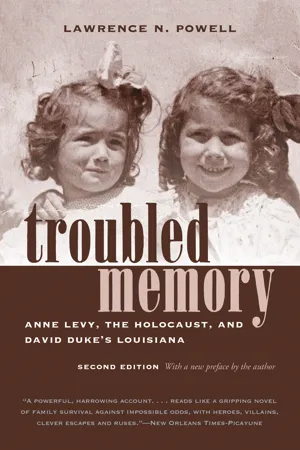![]()
NOTES
Unless otherwise noted, all translations are the author’s.
CHAPTER ONE
1. Duke, interview by Rich.
2. Bridges, Rise of David Duke, 1–20.
3. Lipstadt, Denying the Holocaust, xii.
4. Bill McMahon, “Poll Finds Few Know about Hitler, Nazis,” Baton Rouge Morning-Advocate, January 18, 1992. The editor kindly allowed me to inspect the cross-tab results of the poll, which are available at the newspaper’s offices.
5. Interview with Noles (quotation). Also interviews with Coward; Sartisky; and Barad and Weitzman.
6. New Orleans Jewish Ledger, June 2, July 21, 1961; interviews with Justin Zitler, March 11, 1992; Shep Zitler, February 26, 1992; and Buchsbaum, February 13, 1992.
7. Steven Watsky, “David Duke Confronted by Holocaust Victim,” LSU Daily Reveille, June 8, 1989; Ronni Patriquin, “Duke Acknowledges Holocaust Did Occur,” Shreveport Journal, June 7, 1989; and interviews with Buchsbaum, February 13, 1992, and with Sartisky.
8. Seidel, Holocaust Denial, 66–92; Lipstadt, Denying the Holocaust, 1–29.
9. Duke, interview by Rich.
10. Watsky, “Duke Confronted by Holocaust Victim”; Patriquin, “Duke Acknowledges Holocaust Did Occur.”
11. Herman, Trauma and Recovery, 86.
12. Powell, “Read My Liposuction,” New Republic, October 15, 1990, 18–22; Jason Berry, “Duke’s Disguise,” New York Times, October 16, 1991.
13. Duke, interview by Rich (quotation); NAAWP News, 31, 1984, p. 10; Hill and Wise, Media Resource Packet; Hill, “Nazi Race Doctrine,” 94–111.
14. Zeskind, “Ballot-Box Bigotry”; Ridgeway, Blood in the Face, 63–66; Mintz, Liberty Lobby and the American Right, 104. See also Dionne, Why Americans Hate Politics, 158–59, and Judis, William F. Buckley, Jr., 113–41.
15. “End of File,” Instauration, February 1989, 36.
16. Allen Johnson, “Duke Tape: Blacks Argued for Racial Discrimination in B.R.,” (New Orleans) Louisiana Weekly, March 18, 1989, 1.
17. Powell, “Slouching toward Baton Rouge,” 12–40. For a brilliantly rendered study of the life and times of George Wallace, see Carter, Politics of Rage, esp. 294–370.
18. Wayne King, “Bad Times on the Bayou,” New York Times Magazine, June 11, 1989, 120. On Metairie and the house race, see my “Slouching toward Baton Rouge, 12–40.
19. Allen, Nazi Seizure of Power, 84.
20. On Jewish foreboding about potential anti-Semitism, see Lipset and Raab, Jews and the New American Scene, 88–89, 105–8.
21. Lucian K. Truscott IV, “Hate Gets a Haircut,” Esquire, November 1989, 184.
22. Ibid.
23. “David Duke Digest,” Instauration, March 1990, 37.
24. Eli N. Evans, Provincials, 239–46; Reissman, “New Orleans Jewish Community,” 300–303; Lipset and Raab, Jews and the New American Scene, 82–86.
25. Judith Miller, “Holocaust Survivors, in U.S. Reunion, Ask World to Remember,” New York Times, April 12, 1983, A1; Caryle Murphy, “Survivors Give Thanks, Honor Dead,” Washington Post, April 12, 1983; Newsweek, April 25, 1983, 30–35; Time, April 25, 1983, 19.
26. Anne Levy, “A Survivor Shares,” New Orleans Times-Picayune, April 28, 1983, A10.
27. Ibid.
28. For the story of the successful, if somewhat contentious, effort to build the United States Holocaust Memorial Museum on the mall in Washington, see Linenthal, Preserving Memory.
29. Holocaust: The Obligation to Remember, 22.
30. Levi, Reawakening, 2.
31. Interview with Shep Zitler, February 26, 1992.
32. “Forty Years after Warsaw,” Time, April 25, 1983, 19.
33. Lipstadt, Denying the Holocaust, 2.
34. See, for example, Journal of Historical Review 1 (Spring 1980), and Lipstadt, Denying the Holocaust, 137–208. On the connection between Holocaust revisionism and German neoconservatism, see Richard J. Evans, In Hitler’s Shadow, esp. 166 n, and Maier, Unmasterable Past.
35. Apfelbaum, “Forgetting the Past,” 612.
36. Butz’s argument, as well as that of other “revisionists,” is conveniently delineated in Lipstadt, Denying the Holocaust, 123–36, and in Seidel, Holocaust Denial, 74–82. See also Stern, Holocaust Denial, 10, 11, 70–71. For the NAAWP News quotation, see “Suppressed Books,” NAAWP News, 24, 1983, p. 14.
37. Levy, “A Survivor Shares.”
38. Levi, Survival in Auschwitz, 5–6.
39. Interview with Tritt.
40. Interview with Robin Levy, February 25, 1992.
41. Ibid.
42. Interview with Rickey; Rickey, “The Nazi and the Republicans,” 65–71.
43. Ibid.
44. Herman, Trauma and Recovery, 133.
45. Interview with Robin Levy, February 25, 1992.
46. In her treatment of survivors, the psychiatrist Yael Danieli encourages patients to reconstruct their family trees, recording the death of each relative, to re-create continuity between past and present. See her “Treating Survivors and Children of Survivors of the Nazi Holocaust,” 23–42.
CHAPTER TWO
1. Interview with Dolek Skorecki, Haifa, Israel, October, 5, 1993.
2. Death Certificate of Szmil-Zawel Skorecki, Łódź Birth, Marriage, and Death Records Office; interview with Bresler.
3. Epstein, “Uncovering Moravia,” 95.
4. I bought eleven unbound synagogue journals, dating from the 1820s, 1830s, and 1840s, from a young Pole who stumbled out of a tavern as I was leaving Działoszyce during a brief 1993 car trip to the town. They are currently housed in the Jewish Historical Institute in Warsaw.
5. Quoted in “Fifty Years of the Voluntary Fire Brigade of Działoszyce,” in Yizkor Book, 7.
6. The Hebrew word for Germany, Ashkenazi is the term for Jews from Central and Eastern Europe.
7. In fact, by 1880, the eve of the great migration to the United States, four-fifths of world Jewry lived within the boundaries of the former Polish Commonwealth.
8. Marcus, Social and Political History of the Jews in Poland, 3–8.
9. Rosman, The Lord’s Jews, 2–17, 36–40, 71, 75–87, 104, 112–13; Levine, Economic Origins of Anti-Semitism, 9, 57–74; Barbara Kirshenblatt-Gimblett, introduction to Zborowski and Herzog, Life Is with People, xv, xix–xxii; Schama, Landscape and Memory, 42–43; Epstein, “Uncovering Moravia,” 98–102; Davies, God’s Playground, 1:256–72; Ascherson, Struggles for Poland, 18–19. See also Weinryb, Jews of Poland.
10. Rosman, The Lord’s Jews, 10...
